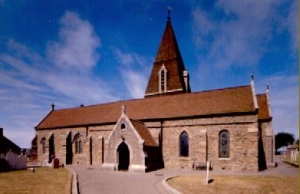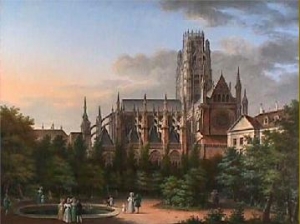St. Ouen’s church is situated on the crest of a hill overlooking the Atlantic ocean and down the slope from the church is one of the finest dune areas in Europe, the Les Mielles Conservation area, as well as Jersey’s largest freshwater lake the La Mare au Seigneur. I doubt if there could be a finer place for our ancestors to be laid to rest than in the peace and tranquillity of St. Ouen’s churchyard.
The church, whilst much changed over the centuries is certainly over one thousand years old as it was mentioned in a document at the time of William the Conqueror in 1066. It is likely that the original building which would probably have been a thatched chapel, would have been replaced or enlarged by an early member of the de Carteret family when they obtained their feudal lordship of St. Ouen after Jersey became part of the Duchy of Normandy in 933AD.
Prior to 1130 there would have been no altar at the church as none could be consecrated unless it contained a relic. So in September 1130 a tiny splinter of bone from St.Ouen, a famous 7th century archbishop of Rouen in France was obtained, probably from a church in Normandy.
Saint Ouen himself was born around 609AD at Saucy, France. His feast day is on the 24th August of each year. Until age 40 he was an important court official of the French courts.
Having founded the Abbey of Rebais, in 641 he was appointed the see of Rouen, where the great cathedral of the capital of Normandy which is pictured to the left was named after him, and still is to this day. He died in 684 at Clichy near Paris.
In 1167 Phillipe De Carteret, with the consent of his wife Nicola, his son Renaud, and his nephew William, gave to the abbey of Mont-St-Michel in France the church of St. Ouen together with the chapel of St. Mary and a neighbouring dwelling, as well as gifts of straw, oats, a cloak, a pair of boots, basins, a cloth and candles, in return for which a member of the family was to be received into the abbey as a monk.
And you thought your children’s school fees were high !!
Anyway, as a direct result of belonging to a wealthy abbey, the church was gradually enlarged. There are many features of note but perhaps two of the best are chapel of the Epiphany constructed in 1310, and the bell tower.
The bell tower had some interior support added, probably in the 13th century when a very heavy peal of bells was added. However the fate of these bells was out of the hands of the parishioners three hundred years later. In 1547 Henry the Eighth died and was succeeded by his son Edward the Sixth who was only nine. Hertford, his uncle who was Governor of Jersey and was a militant anti-catholic, was appointed Protector of the Kingdom and effectively had control. He passed the Chantries Act in 1547. Later, in March 1550 Sir Hugh Poulet was appointed Governor of Jersey for life and he founded a dynasty which ruled the Island for three generations.
He ordered that in order to pay for fortifications at Elizabeth Castle, all church bells would be sold with the exception of one in each parish. So he nicked ours amongst others, and raised the sum of £171!
The present church bell is only 29 years old, having had to be recast from the previous bell which dated from 1884 which was cracked. It’s predecessor dated back to 1812, and the one before that 1754, which was actually made in Jersey by a man named La Source.
Finally, a feature that is normally associated with a church are the pews, but this was not always the case. Before the reformation there were no pews and worshippers either stood or knealt on the earth floor. But after that sermons became longer and pews had to be provided. As with many parishes pews were sold and only those who owned property in the parish could have one. Naturally the best pews were bought by the Seigneurs, and these would have been of a horse box type which would have shielded hem from us commoners!
There were many lawsuits though the courts of Jersey over the pews which were themselves status symbols. Of course you could only sit on your own pew ! Not a good idea to squat a pew, as one lady who sat on one of the Seigneur’s pews found out. She was placed in the churchyard stocks for two Sundays running as an example to others. How embarrassing must that have been !
I will be looking into the allocation of pews to the Viberts in St. Ouen’s church in due course and will post details later. There were some Vibert pews in St. Mary’s church, most notably that of John Este Vibert and a location plan is on his information page.


